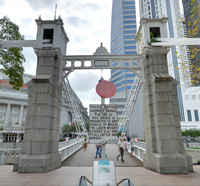Historic iron and steel bridges over Singapore River had witnessed the ebbs and flows of maritime trading and communal living along the Singapore River banks for almost two centuries. Beyond the living heritage these structures embodied, the stories behind them revealed the intriguing relationships among the Straits Settlement Government, the East India Company and the Colonial Office in United Kingdom.
The construction of the historic bridges occurred between 1869 and 1929 and they are unanimously named after important governors and officials that contributed to the administration of the Straits Settlements.
Cavenagh Bridge
Cavenagh Bridge built in 1869, is named after Major-General (MG) Sir William Orfeur Cavenagh, the last India-appointed Governor of the Straits Settlement. He served as Governor between 1859 and 1867.
Cavenagh Bridge is designed by consulting engineer Rowland Mason Ordish who developed a unique “Ordish” rigid cabled-stayed system. This structural design is currently only found in two bridges worldwide: Cavenagh Bridge and Albert Bridge in London, built in 1873.
Loading tests were conducted by manufacturer P&W MacLellan in Glasgow. Components were bolted together and tested at the factory “with a double load equivalent to four times its own weight”. After the successful test, components were shipped to Singapore and riveted on site by local labourers supervised by the Municipal Engineer. Live load testing was further conducted by a party of 120 Sepoys soldiers marching over the completed Cavenagh Bridge.
Anderson Bridge
Anderson Bridge was completed in 1909 and opened officially in 1910. It is named after Sir John Anderson who served as Governor of the Straits Settlement between 1904 and 1911.
The bridge was the first steel bridge in Singapore. By early 20th century, steel had replaced iron as the preferred material for bridges as it offered greater strength and superior resistance to corrosion compared to iron.
The design of Anderson Bridge bears a close resemblance to old Victoria Bridge in Brisbane, Australia. The latter was constructed earlier in 1897 and was designed by A.B. Brandy, a bridge designer based in Sydney. Original construction drawings of Anderson Bridge did closely resemble the old Victoria Bridge but the ornamentation of the four piers had to be simplified during construction due to a lack of funds.
Like earlier bridges, the steelwork used in Anderson Bridge was manufactured in Britain and shipped to Singapore. However non structural components such as the bronze gas lamps, railings, iron castings, etc were manufactured at the Municipal workshops at River Valley Road. This marked the first large scale attempt at developing local steelworks to reduce dependency on British engineering products.
Elgin Bridge
Elgin Bridge built in 1929, is named after Lord Elgin, Governor-General of India from 1861 to 1863, whom the Straits Settlement government and businessmen appealed to when trade and development works were curtailed after the Straits Settlements, including Singapore, was placed under Bengal rule between 1830 and 1867.
Instead of relying on consulting engineers in England to design the bridges, the Colonial Government employed a bridge engineer in 1925 to design new bridges in Singapore. The engineer Mr T.C. Hood is remembered for his designs of Crawford Bridge and Elgin Bridge, which looked very similar, apart from the cross-ties on Elgin Bridge which was necessary due to its much wider span and width.
The locally-based engineer raised the current Elgin Bridge four feet higher than the previous bridge to allow more height clearance during high tide for heavily laden lighter boats to pass through. Hood was also aware that acidic fumes released by factories and warehouses along the river corroded iron and steel bridges. Hence his design which encased concrete around the steelwork helped to prevent corrosion until today.
A project by National Heritage Board.







